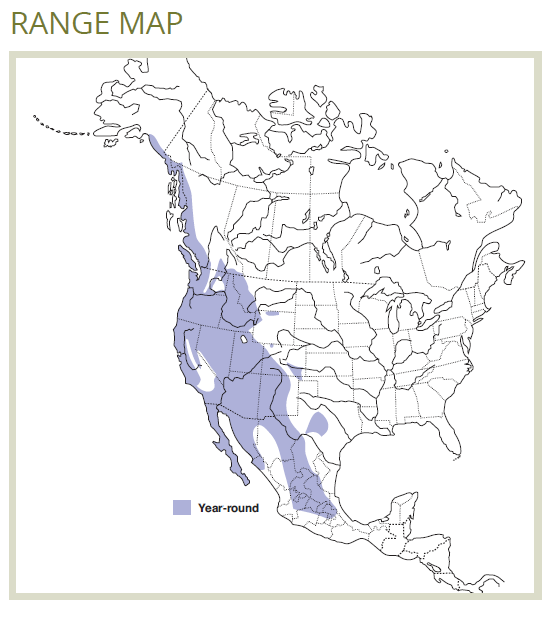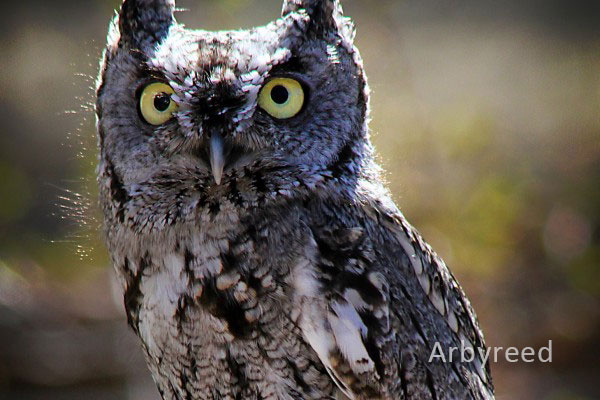The Western Screech-Owl (macfarlanei subspecies) is Threatened in Canada. Managers are responsible for ensuring that they meet the requirements of the Species at Risk Act, the provincial Forest and Range Practices Act, and the Identified Wildlife
Western Screech-Owl
(Megascops kennicottii macfarlanei)
Habitat Ecology
- The Western Screech-Owl has been subdivided into eight populations in BC, each of which has distinct habitat associations.
- This species is mainly found in lowland riparian habitats including black cottonwood, water birch, and trembling aspen.2 These riparian habitats are usually within a landscape matrix that contains mixed coniferous stands (e.g., Douglas fir or ponderosa pine) where they forage.3
- Western Screech-Owls nest in tree cavities, including natural cavities and old Northern Flicker and Pileated Woodpecker nests.2 Nest trees are >25 cm dbh,2 decay class 2–6,1 and have cavity openings >7.5 cm in diameter.4
- Nesting habitats include a moderate to dense understory of shrubs >2 m tall, with open ground, high tree cover (>70%), and multiple large-diameter trees for both nesting and roosting.5
- Important foraging habitats include fields, pastures, rivers, streams, open woodlands, and other open habitats provided there are perches from which owls may hunt.4

Response to Forest Management
- The primary causes of Western Screech-Owl declines include habitat conversion for residential and agricultural developments. However, the continued removal of existing or potential habitats through harvest and fuel management (e.g., thinning) have the potential for severe negative effects.5
- While Western Screech-Owl territories normally occur within riparian areas, these are often small, non-fish-bearing streams and wetlands, meaning they are not subject to riparian buffers by default.1
Stand-level Recommendations
- Prior to all activities, managers are encouraged to review known Western Screech-Owl occurrences to determine whether planned operations are near or within recorded nesting territories. Targeted surveys (e.g., nocturnal call-playback surveys) are recommended in areas near known locations to improve provincial inventories and better protect nesting habitats.
- Suitable wildlife trees and/or nesting sites (see Habitat Ecology) within known or potential nesting habitats should be prioritized for retention, most likely but not exclusively through voluntary riparian buffers. Wildlife tree areas should be >2.5 ha and prioritize retention of black cottonwood/trembling aspen/water birch trees >35 cm dbh and Douglas-fir >75 cm dbh.1
- Minimum 50-m buffers are suggested for low-impact activities near occupied nests. Larger buffers for high-impact activities are advisable, however this species is very tolerant of human disturbance.5,6
Landscape-level Recommendations
- Riparian habitats have been shown to be essential to the Western Screech-Owl. In the Shuswap River Valley, most owls had home ranges (65–77 ha) containing >10 ha late-seral riparian forest habitats.7 This proportion may be a suitable landscape target within timber supply areas, mixed with open areas for foraging.
- This species’ habitat associations vary by region. In the Trail/Nelson area, coniferous cover (especially western red cedar) plays a more important role than other areas, where black cottonwood and trembling aspen are the most important component of riparian forests.8
- Many new Wildlife Habitat Areas have been proposed/defined where this species is known to occur on Crown land.9 Reserves and large retention patches may be helpful to improve connectivity between protected areas, facilitating dispersal of young and improving the genetic connectivity of populations.5
References
- Cannings, R. J. 2004. ‘Interior’ Western Screech-Owl, Otus kennicottii macfarlanei. in Accounts and Measures for Managing Identified Wildlife – Accounts V. 2004 Biodiversity Branch, Identified Wildlife Management Strategy, Victoria, BC.
- Cannings, R. J., Angell, T., Pyle, P. & Patten, M. A. 2017. Western Screech-Owl (Megascops kennicottii), version 3.0. in The Birds of North America (Rodewald, P. G., ed.) Cornell Lab of Ornithology, Ithaca, New York, USA.
- COSEWIC. 2012. COSEWIC assessment and status report on the Western Screech-Owl kennicottii subspecies (Megascops kennicottii kennicottii) and the Western Screech-Owl macfarlanei subspecies (Megascops kennicottii macfarlanei) in Canada. Committee on the Status of Endangered Wildlife in Canada, Ottawa. xii + 30 pp.
- Western Screech-Owl macfarlanei subspecies Recovery Team. 2008. Recovery Strategy for the Western Screech-Owl, macfarlanei subspecies (Megascops kennicottii macfarlanei) in British Columbia. Prepared for the BC Ministry of Environment, Victoria, BC. 14 pp.
- B.C. Ministry of Environment. 2016. Recovery Plan for the Western Screech-Owl, macfarlanei subspecies (Megascops kennicottii macfarlanei) in British Columbia. B.C. Ministry of Environment, Victoria, BC. 27 pp. Available online: http://www2.gov.bc.ca/gov/content/environment/plants-animals-ecosystems/…
- Hane, M. 2016. Western screech-owls (Megascops kennicottii) use stump nest during active logging operation. Journal of Raptor Research 50: 226–227. Available online: http://www.bioone.org/doi/full/10.3356/0892-1016-50.2.226
- Davis, H. & Weir, R. D. 2010. Home ranges and spatial organization of Western Screech-Owls in southern British Columbia. Northwestern Naturalist 91: 157–164. Available online: http://www.bioone.org/doi/abs/10.1898/NWN08-048.1
- Hausleitner, D., Dulisse, J., Manley, I. & Waterhouse, A. 2017. Nest habitat selection of Western Screech-Owls (Megascops kennicottii macfarlenei) at multiple spatial scales in southeastern British Columbia. Journal of Ecosystems & Management 17: 1–8. Available online: http://jem-online.org/index.php/jem/article/view/592/512
- Hobbs, J. 2013. Western Screech-Owl Conservation and Management for the Bridge-Seton Area: 2012 Survey – Final Report. Prepared for Fish and Wildlife Compensation Program and Habitat Conservation Trust Foundation. BC Ministry of Natiral Resource Operations, Victoria, BC. 27 pp. Available online: http://www.env.gov.bc.ca/wildlife/wsi/reports/4956_WSI_4956_RPT_2012.PDF








